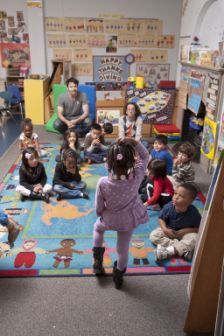The Master List of Questions to Ask When Seeking Boston Care

Are you a working parent in Massachusetts seeking Cambridge daycare or Boston care? The Boston area offers one of the most extensive child care opportunities out of cities across the country. After you’ve sorted through your options, using Mom Trusted’s search tool, picked your favorites and set up tours with your top choices, it’s time to lay out the questions to ask to figure out if you’re choosing the best Boston care option for your little ones. Here’s what to ask:
Fundamentals:
How long have you been in business?
What are your hours?
How is vacation time handled?
Safety:
Are you properly licensed with the state?
Are all of your staff members CPR and First Aid certified?
Are staff members required to go through background checks before hiring?
How would you handle a missing child?
The Numbers Game:
How much will it cost for my child to attend?
What is your late policy?
How is billing handled?
How many staff members are there?
What’s the child-to-teacher ratio?
How many of your staff members are required to hold a degree?
Food and Health:
What’s your sick policy?
Are there any food restrictions?
My child is allergic to ____. How would you deal with his or her allergy?
How are snack and mealtimes handled?
What type of food do you serve?
How does nap time work?
Learning Style:
Which teaching philosophy do you follow here?
In terms of learning, which approach do you find to be most effective?
What are some of the main subjects you focus on throughout an average day?
Behavior:
How do you deal with disciplining here?
Do you believe in spanking?
My child struggles with ____ and this is how we handle it at home: _____. Could you respect and continue to enforce our rules?
How do you handle potty training?
What do you expect from me as a parent?
Environment:
Can you describe an average day to me here?
How much time is spent inside versus out?
What is your policy on TV and computer time?
Can you show me some crafts kids here have made?
Can you describe some of the games children play here?
Sources:
-“Home daycare provider interview” Baby Center
-“Questions to Ask When Choosing Child Care” Al.com
-“Questions to Ask a Home-Based Daycare Provider” PDX
Photo By lee
Arts Based Early Education
As a substitute teacher, I sure have encountered a lot of different education programs. I’ve been at big and small schools, public and private, and have taught early education through high school. While a one-off day at a school is usually quickly forgotten, getting to see (and briefly be a part of) a really impressive program is a treat!
Recently, I spent the day teaching for the Kaleidoscope Program at Settlement Music School in Philadelphia. My background (and my heart) is in Art Education, so I jump at any chance to work in an arts based early education environment – especially an award winning community based school in my own hood!
Throughout my day, I was excited to see young kids (pre-K) who were really getting a well rounded arts education! The kids in my art classes had obviously been exposed to the “elements of design”, and were comfortable with some fairly advanced color theory. The day I spent with them, we were working with hot and cool colors. The students definitely had both the knowledge and vocabulary to talk about their own and others’ art work.
I was also able to observe the Kaleidoscope Plus program, Settlement’s new after-school program. Much like the day program, Kaleidoscope Plus has a major focus on the arts – visual arts, music, theater and dance. In my experience, there are some major benefits to presenting art, music, and movement in an integrated curriculum. Students gain skills in all areas – learning principles of art, developing fine motor skills, enhancing their listening skills and music making abilities, and moving their bodies in controlled and intentional ways.

Above, students are enthusiastically engage in a game of “Freeze Dance Party “ – accompanied by live music! Even some of the shyest kids were socializing in this dance game!
This cross-disciplinary approach allows broader topics and themes to be explored. Over the course of this school year, Kaleidoscope Plus kids will be learning and creating around three major themes – myself, my community, my world. While I was visiting, students we’re focusing on “myself”. In the choice-based art classroom, this meant learning about our bodies and making a larger-than-life skeleton. (I do love a good 3-d project!)

On the more “dramatic” side of things, kids learned about storytelling, which culminated in mini-performances to rapt audiences of their peers. It’s obvious that these guys are confident in front of a group!
Here, kids participate in favorite game “mirror” – learning about the expressions they can make with their faces.
Overall, it was charming and fun to spend an afternoon with kids that were really learning – while not losing sight of the main focus: play. It was awesome to see kids really interacting, creating, and expressing themselves all afternoon. I found myself wishing I had been in a program like this when I was that little!
More information on Kaleidoscope Plus (including their mission statement, and enrollment pages) is available here. You can still enroll or start in January, after the holidays!
Free Program at CHALK Preschool Makes Early Education Accessible for All
We promise it’s not too good to be true. CHALK Preschool offers an online curriculum to children across the world for absolutely no cost at all. With preschool tuition on a seemly constant rise, the option for free learning is key.
In recent years, preschool has gotten so expensive that it’s even been compared to college tuition costs. Depending on location and which specific program parents choose, preschool for just one child could set them back anywhere between $4,400 and $13,000 each year. The average cost of tuition at a public college is under $9,000. That means that parents could actually pay more for their child’s preschool education than they do for their college. And as a country, we can’t afford these steep tuition costs. College students and grads owe around $1 trillion in student loans, begging the question, if we can’t afford to pay for our children’s college tuitions, how can we afford to pay around the same amount for their preschool education?
That’s where CHALK comes in. Because of this interactive preschool option, children across the world are able to attend preschool. The online, free curriculum through CHALK Preschool is accessible to everyone, regardless of household income. It gives children across the world access to a quality, early learning education. The program is open to any child, but primarily aimed at kids between the ages of two and five.
Learning is vital within those first five years. It can pave the road for academic success in the future. Kids who attend preschool enter kindergarten with a higher understanding of vocabulary, math and pre-literacy skills. And a preschool education goes beyond the books. It teaches children to socialize and can even help develop motor skills. Later in life, preschool matters. Studies show that adults who attended preschool are less likely to be held back in school, placed in special education, rely on welfare or even break laws. There’s no doubt that preschool plays a big role in both the immediate and future success of children.
Everyone should be given the advantage of preschool. Because CHALK knows the importance of an early education, they strive to make it accessible to all children. To enroll your child in CHALK Preschool’s free online program, simply visit the site and register today!
Sources:
-“Preschool: How much does it cost?” Baby Center
-“What’s the price tag for a college education?” College Data
-“Why preschool matters” Parents.com
Family Fitness: Staying Fit as a Family
Looking for a fresh start to 2014? What could be better than working on your family fitness by spending some quality together? Here are some family friendly activities that involve exercise, but are guaranteed to be more fun than the gym:
Bike
Grab everyone in the family a bike and set off on a two-wheel adventure. If your kids haven’t mastered the balancing technique yet, throw on some training wheels. And if your little one is way too little to pedal on his or her own, invest in a bike with a child seat or a child trailer so even the smallest munchkins can join in on the fun. Plus, you don’t just have to bike on adventures. You can use your new wheels for running errands too.
Take a hike
Let your little ones lose in the great outdoors. Go on a backpacking trip together. If you just go for a night or two, you shouldn’t need too much gear, but should be able to explore beautiful sites while staying active. If you’re worried about your little one on the path, consider a baby carrier to strap to your chest or just taking a day hike.
Play ball
It doesn’t matter if it’s soccer, football, baseball or any other sport. The point is that you’re all moving and having fun as a family. Get out in your back yard and throw a ball around. Invite neighborhood families too! The bigger the teams, the better.
Dance
Little ones love to boogie so throw a dance party in your own house. Crank up the music, get dressed up and get down.
Sources:
-“7 Family Exercise Activities.” Life Script
-“Making Fitness a Family Affair.” Great Schools
-Photo courtesy of photostock/freedigitalphotos.net
Teaching Preschoolers About Money
A couple of months ago, in the midst of the government shutdown, the U.S. Treasury started printing new $100 bills. The new bills are more expensive to produce than the ones we’re familiar with. Each bill costs nearly five cents extra to create. In honor of the new $100 bills, we’ve put together a few ideas for teaching preschoolers about money:
New $100 Coloring Page and Lesson Plan
We created a coloring page so you and your kids can decorate your own $100 bills, cut them out, and make play money. Plus we also added in a few other ideas for introducing the concept of currency to your little ones.
Give them an allowance
Parents interested in teaching their children the value of money can give them a small allowance. Even a simple $5 per week will work great. The idea isn’t to give money though. The allowance should teach the value of money, so it works best if little ones need to do some chores around the house to earn it. Maybe they make their bed every day or wash dishes. The idea is to teach them to work for and appreciate their little income and to save for special toys, books or other items that cost more than their allotted income.
Count and sort coins
Counting and sorting change will help teach kids the values of different coins. First, teach the preschoolers the names of each coin. Then, after those have been memorized, introduce their values. Use visuals to your advantage. Put five pennies together, next to a nickel. Then, explain that the five pennies equal one nickel. Do this for each coin and experiment by putting together different combinations.
Order coins
After the preschooler has mastered the monetary value of each coin, make a game out of it. Place coins on a table and have the preschooler sort them from most valuable to least. Then, place different coin combinations on the table and have the child or children do the same activity with groups of change.
Sources:
-“Money Games and Activities” Nick Jr.: http://www.nickjr.com/home-life/kids-money/money-games-activities/money-games-activities_ap.html
-“A preschooler’s allowance” Simple Mom: http://simplemom.net/a-preschoolers-allowance/
-“These New $100 Bills Are Going to be Huge Overseas” BloombergBusinessWeek: http://www.businessweek.com/articles/2013-10-08/these-new-100-bills-are-going-to-be-huge-overseas
Keeping Kids Safe this Holiday Season
From hot ovens to broken glass ornaments, there are plenty of safety hazards around the holidays. MomTrusted came up with some simple tips to help keep children safe this season.
Invest in an artificial tree.
Avoid the real deal this year and invest in a fake tree. Real ones pose as a serious fire hazard, but buying a fire resistant artificial one will help keep the flames away. Miss the process of picking one out and cutting it down? Take the kids on a winter hike instead. You can still go stomp around in the snow and smell fresh pine, but you won’t get stuck with the process of lugging a tree home. Collect pinecones, on your hike, to decorate with instead of a gigantic tree.
Bundle up.
Little ones love to play in the snow. Encourage them to make snow angels and build snowmen, but make sure they’re bundled from head to toe first. Frostbite is not something you want to mess. Also invest in gloves with sleeves attached. Not only will these keep snow from creeping up your children’s sleeves, but they’ll be much more difficult for the little ones to pull off when they’re playing outdoors.
Avoid tunneling through the snow.
Snow tunnels and igloos may seem fun, but if the snow caves in, little tunnelers could end up trapped or worse. Tightly packed snow can result in suffocation.
Keep ornaments high.
Shiny ornaments can catch the eyes of little ones quickly and before you know it, you can have tiny hands grabbing for them. Keep them far out of reach to avoid tipped trees and broken class. You may even want to place even non-breakable ones high too. Little piece can be choking hazards and pointy hooks should be kept completely out of reach.
Buy new garland.
Did you know that old garland often contains lead, a main reason for many of today’s toy recalls?
Use lights, not candles.
Enough said.
Sources:
-“Holiday decoration safety smarts.” Baby Zone.
-Photo courtesy of Tom Clare/freedigitalphotos.net
Mommy Math: Playground Safety
Each year, emergency rooms in the U.S. treat more than 200,000 children for playground-related injuries. While some involve bumps and bruises, many are much more serious, resulting in severe fractures, amputations and even death. Although girls are slightly more prone to injuries on playgrounds, the gender at risk is nearly ½ and ½. Playgrounds at low-income locations are more likely to have maintenance-related injuries, but all children who play on both public and private grounds are at risk. MomTrusted has put together a few playground safety tips to help keep your child out of these statistics.
Be present and aware. The best way to practice playground safety is to simply keep an eye on your child. It’s OK to bring a book or magazine, but don’t get so engrossed that you lose watch. If you see your child climbing, hanging or crawling where they shouldn’t, be sure to show them the proper way to use the equipment.
Let your child go down slides on his or her own. Many parents try to protect their toddlers by having them sit on their lab as they go down a slide, but this is a mistake. Hospitals see an alarming number of slide-related injuries due to children sliding down on a parent’s lap. The added height, weight and speed leave room for shoelaces and feet to get caught and dislocated or pulled in unnatural ways. The best solution? Just let your little one slide alone.
Supervised swinging only. Most injuries on back-yard playground sets occur on swings. If you have a toddler, make sure they use a swing with a back for extra support and protection. Watch out for swings’ metal chains, which can pinch little fingers and misuse of them, like standing or jumping off.
Check out the condition of the equipment. Another way to practice playground safety is to keep an eye the equipment as well. Wet, rained-on slides, swings and monkey bars can get super slippery. Sometimes the grounds heat up too much under the summer sun, making them dangerously hot. Keep on the lookout for any broken equipment. Always investigate the condition of a playground before your child plays.
Sources: -“Playground Injuries: Fact Sheet.” CDC -“A Surprising Risk for Toddlers on Playground Slides.” The New York Times -“Playground Safety.” Kids Health

















